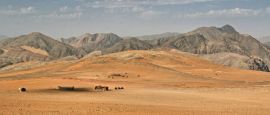Getting around Angola
TAAG Angola Airlines (www.taag.com.br) operates flights within Angola. There are scheduled services between major towns. However, aircraft run by this airline may not be properly maintained, and travellers should aim to use flights run by reputable international organisations.
Private jets are operated by some Portuguese, French and Italian business interests (trading most notably in oil and diamonds) in the north of the country, particularly to and from the Cabinda enclave, which is only accessible by air. Sonair (www.sonair.co.ao) is recommended. Helicopter access to Cabinda is also possible. Passengers on internal flights must carry official authorisation.
Driving outside of Luanda may be risky. Unexploded mines remain, driving standards are poor, and conditions are challenging. Much of the infrastructure was destroyed in the civil war, and although some roads have been rebuilt, many are still in a bad state of repair.
You can find international car hire companies in Luanda; hiring a car with a driver is recommended. Only use a reputable firm.
An International Driving Permit is recommended (or translation of national licence), although, in theory, visitors may drive with a national licence for up to 30 days.
Rail services are erratic, and tickets hard to purchase. Trains run on three separate routes inland from Luanda: to Malanje (daily) with short branches to Dondo and Golungo Alto; Lobito to Dilolo (the Benguela Railway, daily); and Namibe to Menongue (daily). There are no sleeping cars and no air-conditioned services, though food and drink is available on some journeys.
Do you have any Feedback about this page?
© 2025 Columbus Travel Media Ltd. All rights reserved. No part of this site may be reproduced without our written permission, click here for information on Columbus Content Solutions.




 You know where
You know where